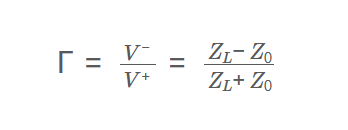 Home
Home
 Back
Back

Definition: This calculator computes the reflection coefficient (\( \Gamma \)) of an RF transmission line, which indicates how much of an electromagnetic wave is reflected due to an impedance mismatch.
Purpose: It assists RF engineers, technicians, and students in analyzing impedance matching in RF systems, helping to optimize power transfer and minimize signal reflections.
The calculator uses the formula:
\( \Gamma = \frac{V^-}{V^+} = \frac{Z_L - Z_0}{Z_L + Z_0} \)
Where:
Steps:
Calculating the reflection coefficient is essential for:
Example 1: Calculate the reflection coefficient for a matched load:
Example 2: Calculate the reflection coefficient for an unmatched load:
Q: Why is the reflection coefficient zero when impedances are matched?
A: When \( Z_L = Z_0 \), there is no impedance mismatch, so no power is reflected, resulting in \( \Gamma = 0 \).
Q: Why do I get an error for zero impedances?
A: The denominator (\( Z_L + Z_0 \)) must not be zero to avoid division by zero in the formula.
Q: What does a reflection coefficient of 1 mean?
A: A \( |\Gamma| = 1 \) indicates total reflection, which occurs with an open or short circuit (e.g., \( Z_L = 0 \) or \( Z_L \to \infty \)).
Q: Why is the result formatted in scientific notation?
A: Values less than 0.001 or greater than 10000 are displayed in scientific notation for readability.